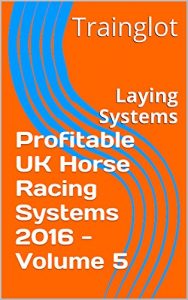In this book you will discover 20 profitable laying systems, clearly explained and described.
It is assumed you are familiar with how to lay horses on Betfair in both the win and place markets, and how to choose BSP. All results are stated at BSP but you may use your own skill and judgement to decide when to lay and at what price.
Note profits are stated based on return from stakes risked, not aim or target stakes that other misleading sites or publications state. If you lay a 10/1 shot for 1 unit stake risked you will get a return of 1.1 units and a profit of .1 or 10%. Using aim or target stakes you would need to risk 10 units in order to win your target of 1 unit.
Only bet what you can afford to lose. Previous results are no guarantee of future performance.
The systems are designed to use only for the 2016 UK turf flat racing season beginning March 2016.
Of these 20, 9 have been selected as the most solid and consistent systems (“Active” Systems). The others should still be profitable overall but are designated as Test Systems.
The recommendation is to lay using Active Systems sections only.
Betting strategies were described in 2015 Volume 1 but using level stakes at Betfair Starting Price will suffice and all results are stated for this method. The profits stated are after Betfair's maximum 5% commission, so profits are larger for higher volume Betfair customers.
Previous 2016 Volumes 1 to 4 were concerned with Backing Systems including those concentrating on Trainers, Sires and Jockeys.
The target overall profit levels for 2016 are 20% for Active Systems and 5% for Test Systems.
Among many other things you will discover in this volume are –
Which type of jockeys can be laid for significant profits when riding 3-year-old favourites?
Which trainers are must-lays with their odds-on shots?
Which stable’s fancied 2-year-old debutants fail to reach the frame more often than not despite apparent market confidence?
Which 2 stables invariably have 2 year olds that don’t improve enough on their 2nd run to justify favouritism?
Which sires offspring hate the mud over long distances despite any market support and can be confidently place laid?
Which 3 jockeys simply don’t have the strength to get the required finish from their mounts over long distances?
Which sires produce offspring that are not built to carry big weights effectively?
Which 9 jockeys need to be opposed on short price favourites, and how do we maximise profits?
It is assumed you are familiar with how to lay horses on Betfair in both the win and place markets, and how to choose BSP. All results are stated at BSP but you may use your own skill and judgement to decide when to lay and at what price.
Note profits are stated based on return from stakes risked, not aim or target stakes that other misleading sites or publications state. If you lay a 10/1 shot for 1 unit stake risked you will get a return of 1.1 units and a profit of .1 or 10%. Using aim or target stakes you would need to risk 10 units in order to win your target of 1 unit.
Only bet what you can afford to lose. Previous results are no guarantee of future performance.
The systems are designed to use only for the 2016 UK turf flat racing season beginning March 2016.
Of these 20, 9 have been selected as the most solid and consistent systems (“Active” Systems). The others should still be profitable overall but are designated as Test Systems.
The recommendation is to lay using Active Systems sections only.
Betting strategies were described in 2015 Volume 1 but using level stakes at Betfair Starting Price will suffice and all results are stated for this method. The profits stated are after Betfair's maximum 5% commission, so profits are larger for higher volume Betfair customers.
Previous 2016 Volumes 1 to 4 were concerned with Backing Systems including those concentrating on Trainers, Sires and Jockeys.
The target overall profit levels for 2016 are 20% for Active Systems and 5% for Test Systems.
Among many other things you will discover in this volume are –
Which type of jockeys can be laid for significant profits when riding 3-year-old favourites?
Which trainers are must-lays with their odds-on shots?
Which stable’s fancied 2-year-old debutants fail to reach the frame more often than not despite apparent market confidence?
Which 2 stables invariably have 2 year olds that don’t improve enough on their 2nd run to justify favouritism?
Which sires offspring hate the mud over long distances despite any market support and can be confidently place laid?
Which 3 jockeys simply don’t have the strength to get the required finish from their mounts over long distances?
Which sires produce offspring that are not built to carry big weights effectively?
Which 9 jockeys need to be opposed on short price favourites, and how do we maximise profits?












